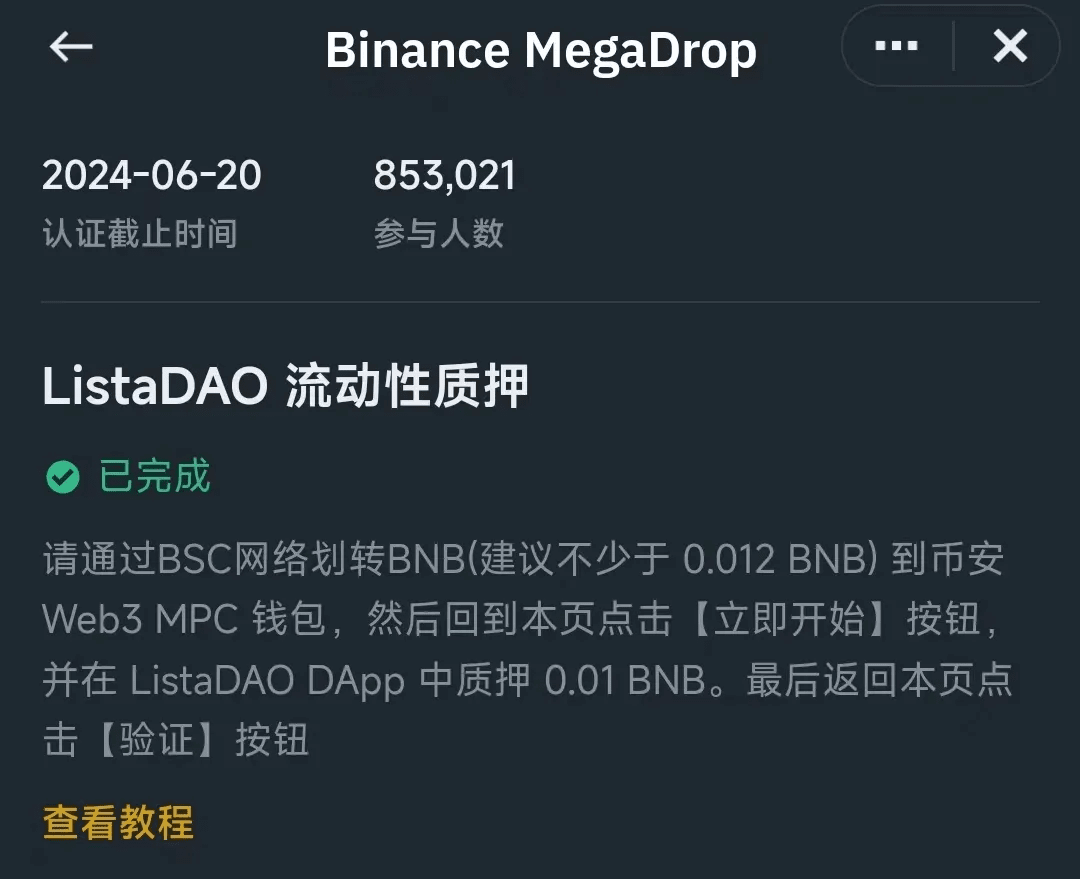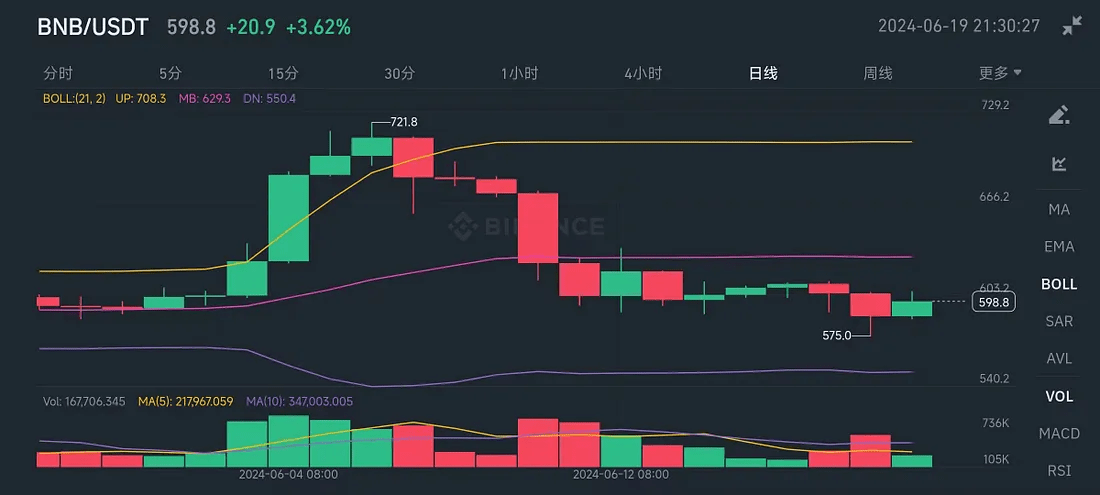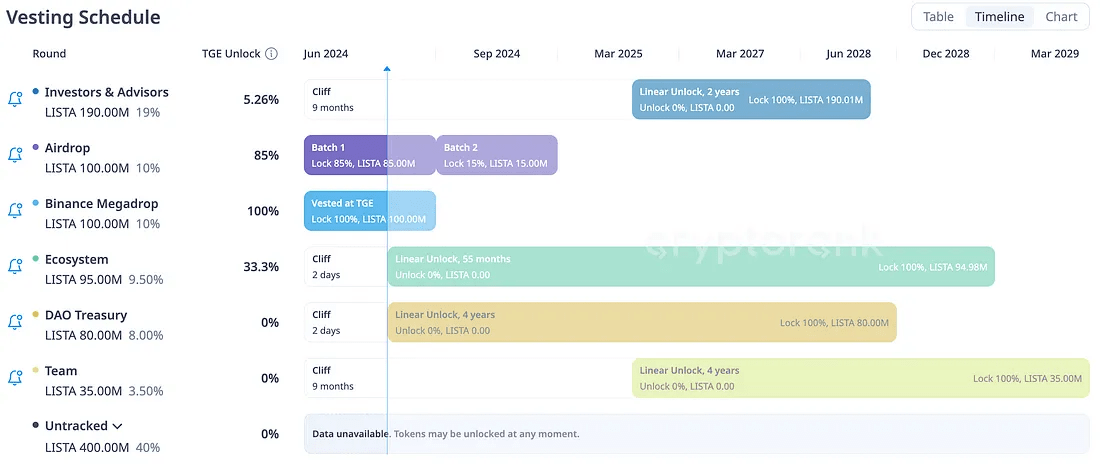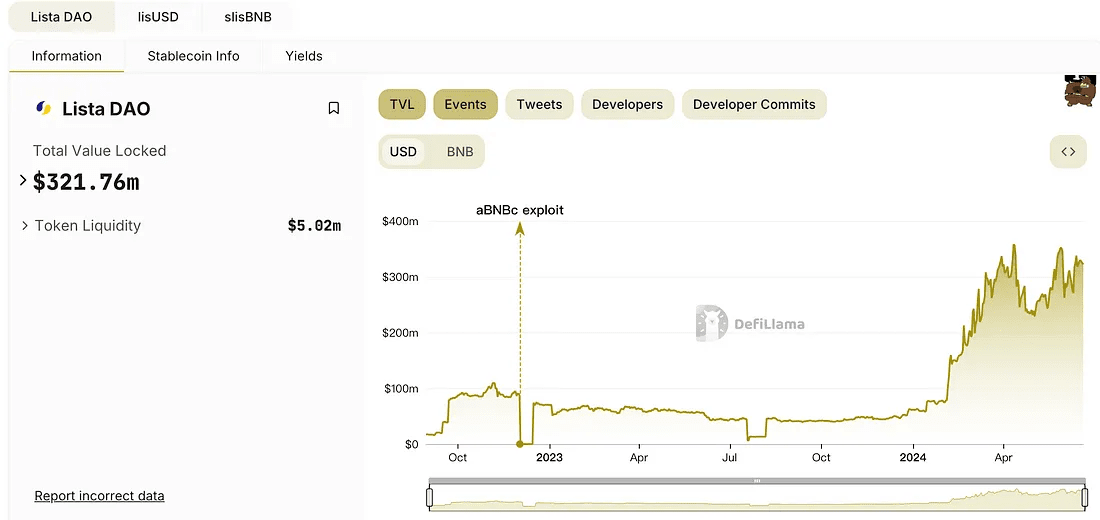Lista was launched on Binance, Bybit, Kucoin, MEXC and other exchanges at 18:00 on June 20th.
Let’s take a look at the data of Megadrop first:
The total number of participants was 870,000, which was about 6% more than the 822,000 in the previous BounceBit. The number of participants in the Web3 task was 852,000, which was nearly double the 433,000 in BounceBit. It can be seen that people are increasingly aware of the importance of the weight of the Web3 task, and the Megadrop drainage effect has increased.
Interestingly, during the MegaDrop period, the number of depositors and trading volume in Lista was directly related to the price of BNB. When the price was high, the number of participants decreased, while when the price of BNB fell, the number of depositors in Lista increased. In particular, on June 18, when BNB fell below 580, the number of depositors on that day increased significantly.

Currently, the amount of BNB pledged for liquidity on Lista has reached more than 390,000.
In terms of tokens, the total amount of $LISTA is 1 billion. According to token economic estimates, the initial circulation is approximately 22.7%.
In the past two days, Pancake has been conducting LISTA's IFO, and the price is 0.02 US dollars.
In 2023, Binance invested 10 million in Lista, and the unlocking condition is 5.25% TGE release, which will be released linearly over 2 years after 9 months of lock-up. According to the 19% investor ratio, the first-level price is about 0.0526 US dollars, and the corresponding TGE price is 1u. From this point of view, Pancake's IFO price is very attractive. I wonder if it can boost Pancake and reproduce its former first-level glory.
Looking at the distribution of the token economy, the team itself only took 3.5%, and most of the tokens were given to the community and ecosystem (10% airdrop, 10% Megadrop, 9.5% ecosystem, 40% community). It is a rare project with a relatively large structure, which may bring a bit of coolness in this summer filled with VC coin FUD.
In addition, looking at the overall on-chain data, Lista’s current TVL is around US$322 million, ranking fourth on BNBChain, and is the largest stablecoin protocol on the BNB chain.
After talking about Lista’s current data, let’s talk about the future prospects of the project.
Lista’s Yin-Yang Bagua-shaped icon represents the integration of liquidity staking and decentralized stablecoins. It itself is a combination of the stablecoin project Helio and the liquidity staking project Synclub.
Some time ago, He Yi said in X Space that Binance is optimistic about the stablecoin track and welcomes cooperation with stablecoin projects. Lista is currently the largest stablecoin protocol on the BNB chain and is also an investment of Binance Labs itself, so how can we not support it?
But there is a question here. Can the stablecoin protocol and liquidity staking project achieve 1+1 greater than 2?
First of all, the biggest factor affecting the prosperity of a public chain is the prosperity of DeFi projects. After all, the most common metric for valuing a chain is TVL. Although DefiLlama avoids the problem of repeated calculations caused by lending or liquidity pledge when calculating TVL, it is difficult to perfectly avoid all repeated calculations as the complexity of the capital path gradually increases. The lending protocol and liquidity pledge protocol of stablecoins are the main DeFi products that can unlock capital liquidity.
In addition, think about it the other way around, what would happen if the LSD project and the stablecoin project were not combined? According to the current mainstream interest-bearing path, most users will still exchange POS native assets for LST assets, and then go to DeFi products for circulation. LSD has many mature product options, why do users have to use your protocol? Most users look at the scale and APR when choosing liquidity pledge products. The scale determines the quality of liquidity, and the APR is not much different from one company to another, so the most important point is liquidity.
So where should the pledged LST be placed? Basically, there are several types of protocols: lending protocols, stablecoin protocols (which are actually also lending in essence), and LP pools. The APR increased by using lending nesting is quite considerable, especially in the quiet market stage, when on-chain transactions are not active and leverage is added when the market is low, the return/risk is relatively high. At this time, users still need to screen protocols, but there are many lending products on the market, and the factors that users consider when choosing are still liquidity and APR.
The combination of liquidity pledge projects and stablecoin projects is essentially a mutual complement of liquidity. Imagine a one-stop shopping district or industrial cluster effect. After buying product A, you need to use it in B. If a place can provide competitive product A and service B at the same time, it will reduce logistics costs and improve efficiency. As a result, the A and B industries in this place will become more prosperous. Similarly, Lista will attract more users with asset interest needs by using the convenience of the same platform, and the improvement of liquidity will attract more users.
Lista's future is probably to expand towards multiple collateral assets and multiple scenarios. In addition to BTC, ETH, BNB original assets and LST assets, the current collateral assets also support multiple LRT assets. According to the roadmap, it will expand to multiple chains in the future.
Finally, let’s look forward to the benefits of this Megadrop.

